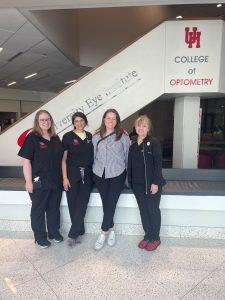1:30min
 Author: Lisa Lombardi
Author: Lisa Lombardi
Low vision (LV) service provision is central to improving patient quality of life and presents as an opportunity for optometrists to maximise their skills to provide holistic vision care for their patients.
I was fortunate to receive support from Optometry Australia to explore low vision and rehabilitation service provision in Texas, USA. The optometry scope of practice in Texas is expanded compared to Australia, with access to oral prescribing rights (involving antibiotics, antivirals and steroids).
In my study tour, I was fortunate to visit the high-profile optometry school University of Houston (UH) and learn about the care provided at UH Eyecare and Centre for Sight Enhancement, as well as the Lions Low Vision Rehabilitation Center of Texas (San Antonio, Texas). I also met with Teachers and Orientation and Mobility specialists from the influential Texas School for the blind and vision impaired (Austin, Texas) and Criss Cole Rehabilitation Center regarding how they structure their education programs and embed low vision rehabilitation services and training into this. The support offered in Texas, is among the best in the USA and we in Australia can learn significantly for their intensive programs.
I was also an accepted speaker at the Southwest Orientation and Mobility Association (SWOMA) conference in Austin and took this opportunity to learn about O&M services in the USA and how they integrate with healthcare services. I presented on a new functional assessment tool which was developed at the Centre for Eye Research Australia in collaboration with our vision impaired participants, O&M specialists and eye health professionals. The Assessment tool for Occupational performance and Mobility – Multisensory approach (ATOMM) could enhance our ability to capture real-world information about how vision impaired participants are coping with daily tasks, which is becoming more important for clinical trial endpoints. After a successful pilot study, we are current recruiting participants for a validation study, in order to demonstrate the reliability and validity of the tool prior to seeking regulatory approval.
I am grateful for Optometry Australia’s support and hope that this may contribute to enhancing low vision rehabilitation services in Australia.
Keep an eye out for Lisa’s full article on her study tour and key learnings in the November 2025 edition of Optometry Connection.